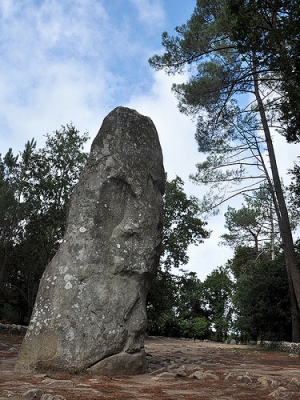

Location: Morbihan department Map
Constructed: 3300- 4500 BC
Official site
Musee de Prehistoire
10 place de la Chapelle
Tel. 02 97 52 22 04
Open: Wed- Mon
Closed: January 1, May 1, December 25
Carnac stones or Karnag in Breton is ancient archaeological site
located in Morbihan department of France. It is situated near a
village of Carnac and La TrinitŽ-sur-Mer in Brittany. It is
famous for its massive megalithic structures that is spread over
large area. The Menhirs or freestanding stones are aligned in
geometric forms and it is similar to that of Stonehenge across
the English channel. In total there have been located over 3000
stones of different sizes and complexity of the alignments.
Many groups of megalithic complexes carry their own name. The
archaeologists date Cahir archaeological site back as old as
4500 BC. The construction of the site lasted till about 2000 BC.
Several legends exist that explain some perfect lines that are
formed by boulders in some areas. Many claim that the stones are
actually Roman legions that were stopped by legendary wizard
Merlin. Others claim that it was in fact Christian pope
Cornelius in the middle of the third century who did the same.
In reality, however the Carnac stones existed long before Romans
and Celtic tribes ever showed up. Subsequent generations of
different nations have used these stones for road construction,
building of peasant houses, chicken sheds, cattle and humans
shelters and other uses. It is possible that all the alignments
made up one single group of boulders, but over time their
removal left only few areas of the original formation.
The stones of Carnac is still a mystery. Many historians and
archaeologists still debate on the significance and purpose of
these massive prehistoric complexes. Some claim that it helped
the ancients to celebrate the solstices, while other claim it
was merely a symbol of prestige. And there is also other
theories that blame everything on the little green men from
outer space.
Kermario alignment is also known as "House of the Dead". The complex consists of 10 rows of stones that reach length of 1300 meters (4300 feet). They spread in different directions forming a fan like structure. There is also a stone circle in the east end. It probably served as the centre piece for ancient pagan rituals. In total this site consists of 1029 stone slabs.
Kerlescan alignment consists of 555 stones that are divided in 13 lines. Each line reach the length of 800 meters (2600 ft). Stone size range from 80 cm (2ft 7in) to 4 meters (13 feet). In the north side of the alignment there is a stone circle.
Ménec alignment is one of the largest in the region and one of the best planned stone formations. Eight to ten rows of menhirs form a rectangle 1165 meters long and 100 meters wide (3822 feet by 330 ft). Additionally the site contains two cromlech on the eastern and western sides of the structure. Cromlech is usually referred to round stone structures for religious or more often burial purposes. The largest slab in Menec alignment is 4 meters (13 feet) high.
Petit-Ménec alignment is located near community of La Trinité-sur-Mer that lies just to the East of Carnac. This is a fairly small megalithic structure lost in the woods. You might need help from the locals to locate it.
Tumuli are burial chambers of the ancient people. Carnac is home
to several of these interesting and unique structures. These
were probably reserved to the riches members of society or to
the most important like wizards, priests and etc. Along with the
body ancient tribes left all the important objects that the dead
might need in the afterlife. During archaeological digs
scientists discovered several stone chests filled with jewelry,
pottery and other small objects.
The most famous tumulus
is that of Saint- Michel. It was constructed somewhere between
5000 BC and 3400 BC. It measures 125 m by 60 m and reaches a
height of 12 m. It held a burial chamber with bodies of royals.
Their subjects put various objects so that their rulers could
use them in the afterlife. Existence of tumulus was widely
known, but it was believed to be an old pagan temple. Since
pagan rituals often involved bloody sacrifices it was assumed
that the megalithic formation was also a site of cruel
practices. A Christian church was constructed in 1663 and later
rebuild in 1813. It was first excavated in 1862 by Rene Galles.
It was also excavated between 1900 and 1907. Most of jewellery,
pottery and other artifacts are currently held in the Museum of
Prehistory of Carnac.
Carnac Dolmens are megalithic structures that probably served as burial grounds for ancient tribes. Some of these formations were later used by farmers as a shelter for themselves or their animals. Dolmen consists of two upright stones with a horizontal places on top. However than you have two or more of these units they are called Allee couverte or covered alleys. These were probably constructed to hold bodies of more people.
